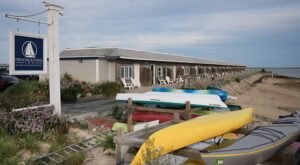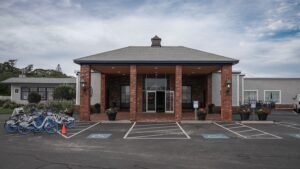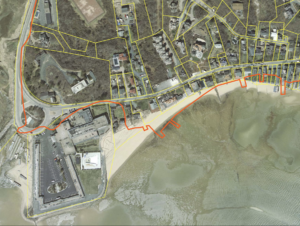PROVINCETOWN — The six-acre property at 1 Commercial St. that encompasses the 102-room Provincetown Inn and its 125 parking spaces, six conference rooms, and swimming pool shaped like a Pilgrim’s Hat is certainly unique. The first hotel on this site was built in 1925, according to David W. Dunlap’s Building Provincetown, and in 1957 owner Chester Peck Jr. built a four-acre peninsula into the tidelands, using enormous granite blocks to triple the size of his waterfront property.

That property is now for sale, and listing agent John Ciluzzi described it as being “without peer.”
“It’s an extraordinary opportunity to either continue with the legacy waterfront property or be the start of something new with a development,” Ciluzzi said. “There are many different options available to anyone who’s interested in investing in the site.”
An expanded conference business, a residential project, or even workforce housing are possibilities, Ciluzzi said, and he has already been getting inquiries from local, regional, and national investors.
Ciluzzi declined to estimate how many residential units might be allowed on the site.
“It’s going to be for buyers to determine what they can and can’t do with the site,” he said. “Our job is to present the opportunity to the marketplace.”
“I try not to hypothesize, because there are so many factors,” said Town Planner Thaddeus Soulé of the redevelopment possibilities. “If you have enough time, money, and lawyers, nearly anything’s possible.”

Soulé said the biggest limiting factors at the site are environmental: it sits on filled Commonwealth tidelands and is in FEMA’s floodplain.
Nearly the entire property is below the historic mean high-water mark, which means the state has claims on the land under the Mass. Public Waterfront Act, also known as Chapter 91.
The state Dept. of Environmental Protection issues Chapter 91 licenses, Soulé said. Any new structure, or even a change in use of an existing structure, would require a Chapter 91 authorization from the state.
The Provincetown Inn also sits in a FEMA AE-9 flood zone, with a base flood elevation of 9 feet above sea level. The western edge of the hotel sits in a VE-14 “velocity” zone, so named due to the potential for powerful wave energy, with a base flood elevation of 14 feet above sea level.
Provincetown has 10-foot tides, and the normal high-tide line is about 5 feet above sea level. In the AE-9 zone, the floor level of a reconstructed building must be 9 feet above sea level, which is only 4 feet above the highest normal tides here.
In the VE-14 zone, however, things are different. The lowest structural element in a reconstructed building in this zone must be 16 feet above sea level to account for wave energy — which is 11 feet above the normal high-tide line.
“If a piece of the building is in the V-zone, then the V-zone applies to the whole building,” Soulé said.

Consequently, if the building were substantially reconstructed on its existing footprint — which would mean the project cost is more than 50 percent of the building’s current assessed value — it would trigger these provisions of the state building code and would need to be raised onto pilings.
The entire property at 1 Commercial St. is currently assessed at $13.9 million, with the building accounting for $6.7 million of that amount. That means a buyer could potentially spend more than $3 million on renovations without having to raise the building.
A developer could also propose a new project that is entirely inside the AE-9 zone and doesn’t touch the velocity zone, in which case only the AE rules would apply, Soulé said.
When it comes to a residential project, there is no clear formula for equating existing hotel rooms to residential units, Soulé said.
He explained that there is a density schedule that relates lot size to residential units, but that is a guideline, not an entitlement, and is subject to other limiting factors. According to the density schedule, a 64,000-square-foot lot can contain 26 units. Beyond that, each 4,500-square-foot increase makes way for one more unit.
If that were the controlling formula, then the 262,667-square-foot parcel at 1 Commercial St. could hold up to 70 units. A separate density schedule for hotel rooms allows up to 152 “commercial accommodations” on the lot.
The Provincetown Inn, however, is in the town’s Residential-1 zone, which by right allows only single-family homes and a peculiar collection of other uses (farming, onshore boat storage, and small-scale solar-power installations).
Because the inn predates the zoning bylaw, its current use as a hotel with meeting spaces and a restaurant are pre-existing nonconforming uses and can also continue by right, Soulé said.
A handful of other uses, including a hotel, a theater, an employee dormitory, and a campground, are allowed by special permit from either the planning board or the zoning board of appeals.
Multifamily housing complexes are not allowed in the use table for Res-1, but that might not be the final word, Soulé said. Hotel rooms can turn into condominiums without going through the zoning bylaw at all, he said. Residential condos could also be a secondary use to a primary use that is allowed, such as a hotel. Much would hinge on how the planning and zoning boards interpret their ability to issue special permits when the benefits to the town outweigh a project’s adverse effects.
“Any project here would likely need review from the planning board, the zoning board of appeals, and the conservation commission,” Soulé said. The property is not in the historic district.
“There are pathways to development,” Soulé said, “and if they depend on special permits, then volunteers on the boards would be guiding that process.”
Elias Schisgall contributed reporting for this story.



